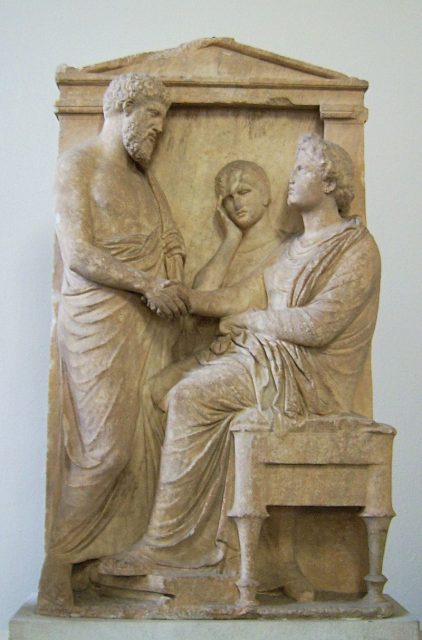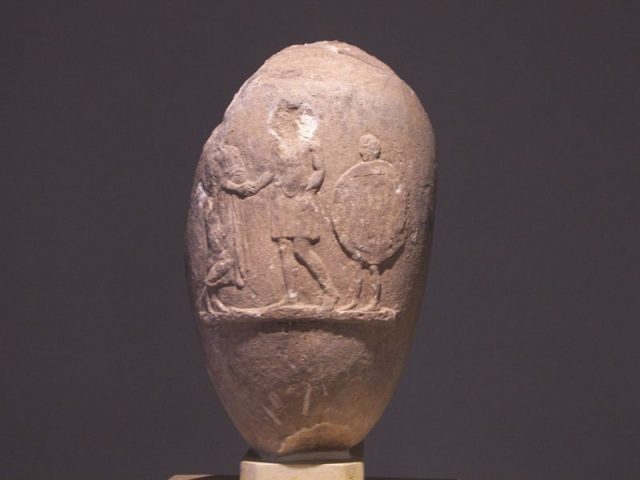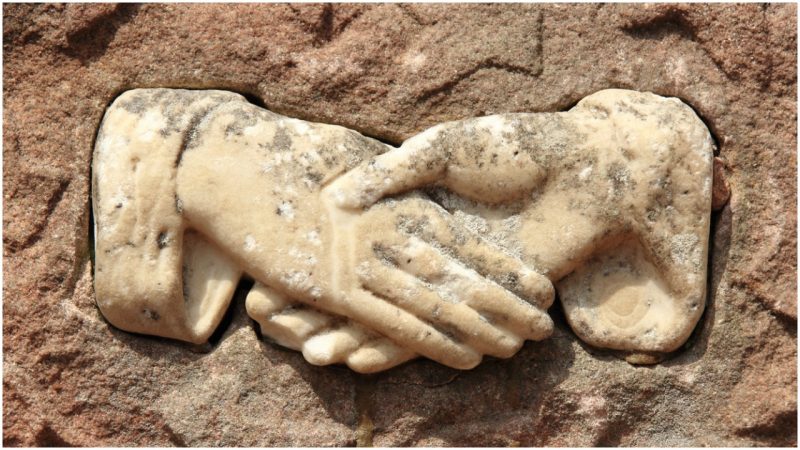Hello! Handshake, high five, fist bump. These ways of greeting a friend or new acquaintance seem so natural and unremarkable now, but how did these gestures originate in the first place?
The handshake dates back the farthest. Archaeological relics suggest that handshakes were practiced in ancient Greece in the 5th century B.C. It was a symbol of peace, showing that you were not carrying a weapon. In Berlin’s Pergamon Museum, the most-visited in Germany, a 5th-century funereal relic shows two soldiers shaking hands. At the Acropolis, in Athens, Greece, a 5th-century stone slab depicts Hera and Athena shaking hands.
The Greek poet Homer describes handshaking several times as displays of trust in his epics The Odyssey and The Iliad. During the Roman era, the handshake evolved to more of an arm grab. Knights in Medieval Europe may have added the shaking of hands up and down as a clever way to dislodge any hidden weapons.

Some historians suggest that modern-day handshaking became popularized by 17th century Quakers, who believed the gesture to be more egalitarian than a hat tip or a bow, according to History.com. In some 17th century marriage portraits, the husband and wife are seen shaking hands as a symbol of their legally binding commitment. By the Victorian era, etiquette guides instructed that the handshake should be firm. While most English-first and Scandinavian countries prefer a firm handshake, in some countries too firm a grip is considered rude and aggressive. Some Asian countries prefer a more gentle touch.
In contrast with the ancient ritual of handshaking, the origins of the high five date back only to last century. And slapping five actually started not up high but down low. The low five has been a fixture of the African American culture since the Jazz Age, as a response to “slap me some skin.” In the 1927 movie The Jazz Singer, Al Jolson slaps low fives to celebrate a Broadway audition.
There’s even a National High Five Day, #NH5D, launched by the University of Virigina to promote youth health and just generally spread good cheer. National High Five Day occurs on the third Thursday of April (coming on the 19th this year). The founders of that day concocted a back story of the high-five’s origin that briefly gained traction on the internet: That a basketball player named Lamont Sleets Jr. had seen his father, Lamont Senior, slapping palms with five veteran brothers from the Vietnam War. And that Junior had incorporated the high five into games as a homage to his father. It was pure fiction, as an ESPN magazine reporter found out when he tracked down Lamont Jr. in 2011. Oh.

CC BY-SA 3.0
In fact, it was Glenn Burke, an outfielder for the Los Angeles Dodgers, who did an impromptu high-five in front of fans in a game against the Houston Astros in October 1977. Burke held up his hand to greet teammate Dusty Baker, who was rounding the bases off his 30th home run. The Dogders were the first team to have four players with 30 home runs.
“His hand was up in the air, and he was arching way back,” Baker told ESPN. “So I reached up and hit his hand. It seemed like the thing to do.” Burke then stepped to the plate and hit his first home in the major league, and Baker high-fived him. The high five became a thing with the L.A. Dodgers and soon sports at large.
The fist bump is the most modern invention. Like the high five, it has its origins in sports. Some trace it to the boxing ring, where opponents touch gloves before a match. Others point to basketball. In the 1970s, star Fred Campbell of the Baltimore Bullets popularized the gesture by giving it his own exuberant flair.
In 2008, Barack Obama brought the fist bump to political headlines when he bumped his wife, Michelle, after his nomination, prompting detractors to denounce it as a “terrorist fist jab.” (Barack Obama was notably passionate about basketball.) The Washington Post called it “the fist bump heard ’round the world.”
The Canadians were quick to embrace the fist bump, or “pound,” as a healthy alternative to germ-spreading handshake, especially during flu season. “It’s a nice replacement of the handshake because you can’t just refuse to shake someone’s hand. It’s rude and seems almost un-Canadian,” Tom Feasby, the dean of medicine at the University of Calgary, told the CBC News in 2009.
Whatever you choose—handshake, high five, fist bump—works just as well for departures, too. Goodbye!
E.L. Hamilton has written about pop culture for a variety of magazines and newspapers, including Rolling Stone, Seventeen, Cosmopolitan, the New York Post and the New York Daily News. She lives in central New Jersey, just west of New York City
